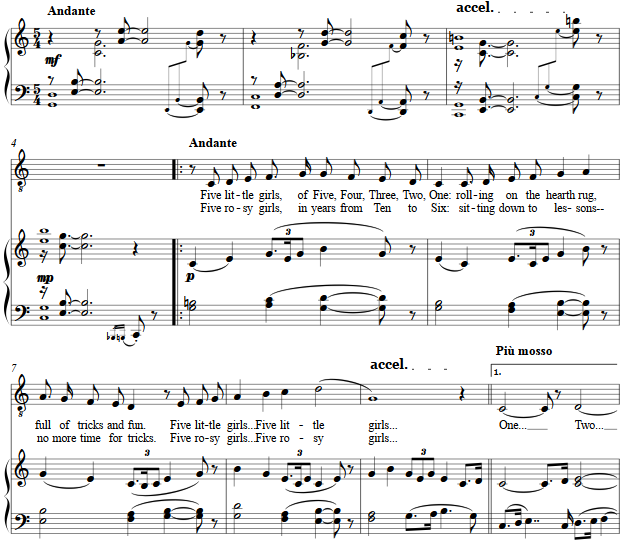Music and Texts of GARY BACHLUND
Vocal Music | Piano | Organ | Chamber Music | Orchestral | Articles and Commentary | Poems and Stories | Miscellany | FAQs
A Game of Fives - (2014)
Lewis Carroll
for tenor and piano
Five little girls, of Five, Four, Three, Two, One:
Rolling on the hearthrug, full of tricks and fun.
Five rosy girls, in years from Ten to Six:
Sitting down to lessons—no more time for tricks.
Five growing girls, from Fifteen to Eleven:
Music, Drawing, Languages, and food enough for seven!
Five winsome girls, from Twenty to Sixteen:
Each young man that calls, I say “Now tell me which you mean!”
Five dashing girls, the youngest Twenty-one:
But, if nobody proposes, what is there to be done?
Five showy girls—but Thirty is an age
When girls may be engaging, but they somehow don’t engage.
Five dressy girls, of Thirty-one or more:
So gracious to the shy young men they snubbed so much before!
Five passé girls—Their age? Well, never mind!
We jog along together, like the rest of human kind:
But the quondam “careless bachelor” begins to think he knows
The answer to that ancient problem “how the money goes”!6 pages, circa 4' 00"
Detail from Charles Dodgson's photograph of the MacDonald family, 1863.
The theme of girls in a family is found throughout many cultures, but in the Victorian era of Lewis Carroll "girls" could be an expense quite different from "boys." Carroll plays his "game of fives" over decades as these girls age, not not "engage" and become "spinsters" -- a term rooted in the notion that unmarried older women spent their time at the spinning wheel, while remaining financially connected to the larger family. Dodgson -- Carroll -- was a friend to the Scottish poet, George MacDonald, and his family, whose children called him "Uncle."
“A Game of Fives” was first published in 1869 in Phantasmagoria and Other Poems, six years after he took the photograph above. For other settings of Carroll's texts, click here.
The setting is in 5/4, counting the number of girls thereby, while the opening gestures are constructed of fifths, thinking about Carroll's penchant for word games, mathematics and acrostics. Thus, this musical game is much about five. The thematic two quarters, a triplet and two more quarters as found in the accompaniment "spins" on through the setting, moving to D flat, G flat, G, and finally back to the tonic of C major.
The vocal line plays the part of the father (or perhaps their uncle), at first enchanted by his girls, then more urgently concerned about costs, then confusion about suitors calling on which of the girls, then worry when the suitors do not propose marriage, then acknowledging that the "girls" perhaps may have been too picky as regards suitable suitors no longer courting them, and finally the rather harsh and yet caring judgment of these "girls" becoming passé.
The summary? It is all about "how the money goes," in this poetic snapshot of one facet of that time and place and society. A final dramaturgical moment conflates all the adjectives together, as the initial observation of "little" move all too quickly towards "passé."
The score for A Game of Fives is available as a free PDF download, though any major commercial performance or recording of the work is prohibited without prior arrangement with the composer. Click on the graphic below for this piano-vocal score.

